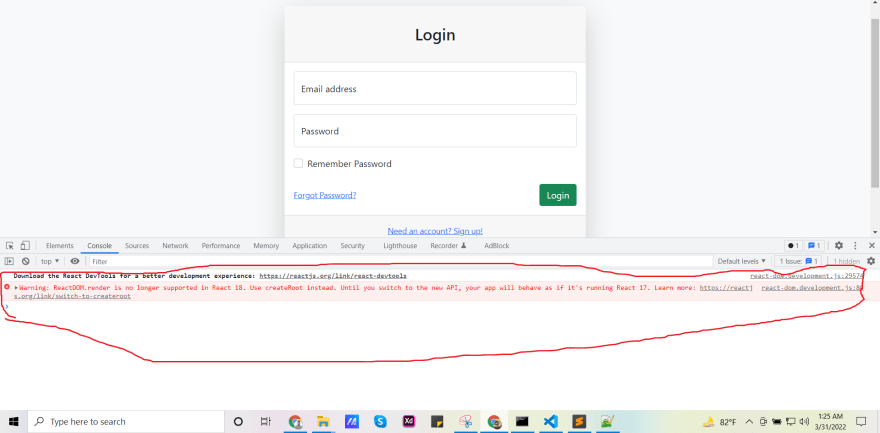Reactdom.Render Is No Longer Supported
1. What is ReactDOM.render?
ReactDOM.render is a function in React that is responsible for rendering elements to the DOM (Document Object Model). It takes two arguments: the React element to be rendered and the DOM element where it should be rendered.
In React, elements are the smallest building blocks of a React application. They are used to describe what should be displayed on the screen. ReactDOM.render plays a crucial role in taking these elements and effectively rendering them on the web page.
2. Announcement of Deprecation
In a recent announcement, the React team declared that ReactDOM.render would be deprecated. This decision was made to improve the overall performance and efficiency of React applications. The deprecation of ReactDOM.render is expected to be effective from React version 18 onwards.
3. Alternatives to ReactDOM.render
To replace ReactDOM.render, React introduces a preferred approach that involves JSX (JavaScript XML) and the ReactDOM hydrate function. JSX allows developers to write HTML-like syntax within JavaScript, making it easier to describe the UI components. The ReactDOM hydrate function is then used to render the React elements into the specified DOM container.
Apart from the preferred approach, there are other alternative render methods available in the React ecosystem. Options like ReactDOMServer.renderToString can be used for server-side rendering, while ReactDOM.createPortal enables rendering elements outside the current DOM hierarchy.
4. Migration Process for Existing Projects
For developers with existing projects that rely on ReactDOM.render, there are several steps to follow during the migration process. First, update the codebase to use JSX syntax for defining UI components. Then, replace the ReactDOM.render function with ReactDOM hydrate, passing the updated JSX element and the DOM container as parameters.
During the migration process, it is important to consider potential challenges such as compatibility issues with other libraries or components. Understanding the differences between ReactDOM.render and ReactDOM hydrate, and how they affect the rendering process, is crucial to ensure a smooth transition.
5. Impact on React Ecosystem
The deprecation of ReactDOM.render has a significant impact on libraries and packages within the React ecosystem. Popular UI frameworks and components that rely on ReactDOM.render will need to update their implementation to use the recommended alternatives. This process may take some time, and developers are advised to check for updates from these libraries or seek community support.
Fortunately, the React community is highly supportive, and resources are available to assist developers during this transition. Online forums, documentation, and community-driven projects can provide valuable guidance and help address any specific issues that arise.
6. Benefits of Deprecating ReactDOM.render
The decision to deprecate ReactDOM.render brings several benefits to React applications. One of the key advantages is improved performance, as the new rendering methods provide optimizations and efficiencies that were not possible with ReactDOM.render. This leads to faster rendering and a more responsive user interface.
Additionally, the new rendering methods enhance compatibility across platforms, making it easier to deliver consistent experiences across different devices and browsers. The use of JSX also simplifies debugging, as developers can easily locate and identify issues within the code.
7. Conclusion
In conclusion, ReactDOM.render is no longer supported by React, and developers are encouraged to migrate to the recommended alternatives. The deprecation of ReactDOM.render brings improved performance, better compatibility, and simpler debugging. By staying up-to-date with React best practices and embracing the new rendering methods, developers can ensure their applications take full advantage of these advancements. While the migration process may require some effort, the long-term benefits will undoubtedly outweigh the initial challenges.
FAQs:
1. Q: Why is ReactDOM.render being deprecated?
A: ReactDOM.render is being deprecated to improve the performance and efficiency of React applications.
2. Q: When will ReactDOM.render no longer be supported?
A: The deprecation of ReactDOM.render is expected to be effective from React version 18 onwards.
3. Q: What are the alternatives to ReactDOM.render?
A: Alternatives to ReactDOM.render include the use of JSX and the ReactDOM hydrate function, along with other methods like ReactDOMServer.renderToString and ReactDOM.createPortal.
4. Q: How can I migrate my existing project to use the recommended alternatives?
A: To migrate your existing project, update the codebase to use JSX syntax, replace ReactDOM.render with ReactDOM hydrate, and ensure compatibility with other libraries or components.
5. Q: What impact does the deprecation of ReactDOM.render have on the React ecosystem?
A: The deprecation of ReactDOM.render requires popular UI frameworks and components to update their implementation. Community support and resources are available to aid developers in this process.
6. Q: What are the benefits of deprecating ReactDOM.render?
A: Deprecating ReactDOM.render brings improved performance, better compatibility, and simpler debugging to React applications.
7. Q: Is the migration process to the alternatives challenging?
A: The migration process may present some challenges, such as compatibility issues, but understanding the differences between the rendering methods and seeking community support can help overcome them.
Deprecation Notice: Reactdom.Render Is No Longer Supported In React 18 Fixed
Keywords searched by users: reactdom.render is no longer supported ReactDOM render not working, reactdom.render react 18, createroot(…): target container is not a dom element., createRoot React 18, Reactdom createroot document getelementbyid root render, ReactDOM webpack_imported_module_1 createRoot is not a function, Root render, property ‘createroot’ does not exist on type ‘typeof import
Categories: Top 76 Reactdom.Render Is No Longer Supported
See more here: nhanvietluanvan.com
Reactdom Render Not Working
When ReactDOM render doesn’t work, it can be quite frustrating, especially for those new to React development. But fear not, as we are here to guide you through the process of diagnosing and resolving these issues.
One of the most common reasons for ReactDOM render not working is improper setup or configuration. Before attempting to render any components, ensure that you have included the necessary dependencies in your HTML file. These dependencies typically include the React and ReactDOM libraries, which can be added via a CDN or locally. Double-check that these dependencies are correctly imported, as any errors in this area may prevent ReactDOM from working as expected.
Another potential issue could be related to the root element where you are attempting to render your components. ReactDOM requires a root element, typically an HTML element with a specific id, to attach the rendered components. Make sure that this root element exists and is accessible in the DOM, as attempting to render components into a non-existent or hidden element will result in a failed render.
Furthermore, it is crucial to confirm that the React components you are trying to render are correctly imported and defined in your application. Check for any typos or incorrect import paths that might lead to rendering errors. Additionally, ensure that the component you are attempting to render is a valid React component, adhering to the proper syntactical rules and patterns.
In some cases, ReactDOM render might not work due to conflicts with other libraries or frameworks. React can coexist with many other JavaScript libraries, but conflicts can still emerge. One common conflict is when multiple versions of React are loaded within the application. This can lead to unexpected behaviors and prevent ReactDOM render from functioning correctly. To resolve this issue, make sure to check for any duplicate or conflicting versions of React and ReactDOM and ensure that only one version is being used throughout the application.
CSS styles can also interfere with the rendering process. It is essential to review your stylesheets and ensure that there are no conflicting styles that may affect the rendering of your components. Overlapping styles or improperly applied CSS rules can cause components to be hidden or positioned incorrectly. Inspect the rendered elements using browser developer tools to identify any potential styling issues that may be interfering with the rendering process.
Another common pitfall is attempting to render components asynchronously or before the necessary data is available. If you are fetching data or performing any asynchronous operations, make sure to render the components only when the data has been successfully retrieved. Incorrectly timed rendering calls can result in empty or incomplete components being rendered.
Lastly, it is essential to be aware of the lifecycle of a React component. Ensure that the ReactDOM render function is called at the appropriate stage of the component’s lifecycle. For instance, attempting to render a component in the constructor or before rendering the component itself will likely cause issues. Always call ReactDOM render after the component has been mounted or updated to ensure that everything works smoothly.
Now, let’s summarize the common questions developers might have regarding ReactDOM render:
Q: What can I do if ReactDOM render is not working?
A: Start by checking for proper setup and configuration, ensure the root element exists, and confirm the correct import and definition of React components. Additionally, watch out for conflicts with other libraries or frameworks and inspect your CSS styles for any potential issues.
Q: Why is nothing being rendered or appearing blank when I use ReactDOM render?
A: This could be due to incorrect timing of the rendering call, hidden or non-existent root element, or conflicting CSS styles.
Q: How can I avoid conflicts with other libraries or frameworks?
A: Ensure that only one version of React and ReactDOM is being used in your application and resolve any conflicting dependencies.
Q: Can I render components asynchronously?
A: Yes, but be cautious about rendering components before necessary data is available. Render components only after data retrieval to avoid empty or incomplete components.
Q: Which stage of a component’s lifecycle should I call ReactDOM render?
A: Call ReactDOM render after the component has been mounted or updated to ensure smooth rendering.
In conclusion, ReactDOM render is a powerful feature of React that allows developers to render and update components. However, it may encounter hiccups at times. By ensuring proper setup and configuration, resolving conflicts, checking for CSS interference, and understanding component lifecycles, you can effectively troubleshoot and resolve issues with ReactDOM render.
Reactdom.Render React 18
I. Introduction to ReactDOM.render:
`ReactDOM.render` is a method provided by the React DOM package that renders a React element or a component to the provided container on a web page. It takes two arguments: the first being the element or component to render, and the second being the container on the web page. The rendering process includes updating the DOM tree based on changes in the React element or component.
II. Benefits of using ReactDOM.render:
1. Efficient DOM updates: ReactDOM.render uses a diffing algorithm, which efficiently compares the new React element with the previous one to identify the minimum necessary changes in the DOM tree. This helps in minimizing unnecessary DOM manipulations, resulting in optimal performance.
2. Reusability: React components are reusable, which means they can be rendered multiple times with different properties. `ReactDOM.render` makes it possible to render the same component with different data, allowing developers to create dynamic and customizable user interfaces.
III. Using ReactDOM.render in React 18:
React 18 introduces several new features and improvements, including changes in the rendering process. Here’s how to use `ReactDOM.render` in React 18:
1. Importing the necessary modules:
To use `ReactDOM.render`, you need to import the `react-dom` module. Simply add the following line at the beginning of your file:
“`javascript
import ReactDOM from ‘react-dom’;
“`
2. Rendering a React component:
Assuming you have a React component called `App`, you can render it to the DOM using `ReactDOM.render` as follows:
“`javascript
ReactDOM.render(
“`
In this example, the `App` component is being rendered to the container with the ID ‘root’ on the web page.
IV. FAQs:
Q1. Can `ReactDOM.render` be used multiple times in an application?
Yes, `ReactDOM.render` can be used multiple times in a React application. You can have multiple root components rendered using different `ReactDOM.render` calls.
Q2. Is it possible to render React elements to other targets besides the DOM?
Yes, `ReactDOM.render` can be used to render React elements into other targets besides the DOM. It supports rendering to a string, which can be useful for server-side rendering or generating static HTML.
Q3. What happens when the underlying data in a rendered component changes?
When the underlying data in a rendered component changes, React performs a virtual DOM diffing process. It identifies the minimum changes required to update the DOM and applies those changes efficiently, resulting in a fast and performant update.
Q4. Is it necessary to render all components using `ReactDOM.render`?
No, it is not necessary to render all components using `ReactDOM.render`. Parent components can render child components internally, and the root component can be rendered using `ReactDOM.render`. Components can also be rendered conditionally based on certain events or conditions.
Q5. Can `ReactDOM.render` be called inside a component?
No, `ReactDOM.render` should not be called inside a component. It should only be called at the root level of a React application. Rendering a component inside another component should be done through normal JSX rendering.
In conclusion, `ReactDOM.render` is a vital method in the React library that enables rendering React elements and components to the DOM. React 18 brings new advancements to the rendering process, allowing for more efficient updates and improved performance. By leveraging `ReactDOM.render`, developers can create highly interactive and dynamic user interfaces while benefiting from React’s reusable component model. With its ease of use and flexibility, `ReactDOM.render` remains an essential tool for modern web development using React.
Images related to the topic reactdom.render is no longer supported

Found 44 images related to reactdom.render is no longer supported theme











![Solved] ReactDOM.render is no longer supported in React 18 - ItsJavaScript Solved] Reactdom.Render Is No Longer Supported In React 18 - Itsjavascript](https://itsjavascript.com/wp-content/uploads/2022/06/react-scripts-command-not-found-390x290.png)









Article link: reactdom.render is no longer supported.
Learn more about the topic reactdom.render is no longer supported.
- ReactDOM.render is no longer supported in React 18 – Stack …
- ReactDOM.render is no longer supported in React 18
- Deprecation notice: ReactDOM.render is no longer supported …
- ReactDOM.render is no longer supported in React 18-Reactjs
- Understanding React 18 root API: ReactDOM.createRoot
See more: https://nhanvietluanvan.com/luat-hoc